Master Hidetaka Nishiyama
(source: 36th AAKF National Tournament program - 1997)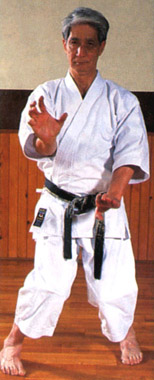 Master Nishiyama is considered to be one of the great masters and pioneers of Japanese Traditional Karate. He began his study in 1943 at the age of fifteen, with master Gichin Funakoshi, the man who introduced Okinawan karate to Japan. At that time, karate was not yet popular. Other martial arts, such as judo and kendo were taught as compulsory classes in Japanese middle schools, similar to American phys-ed classes. After a difficult search he found master Funakoshi and his karate dojo in Tokyo. He continued his study from Funakoshi after he went to college.
Master Nishiyama is considered to be one of the great masters and pioneers of Japanese Traditional Karate. He began his study in 1943 at the age of fifteen, with master Gichin Funakoshi, the man who introduced Okinawan karate to Japan. At that time, karate was not yet popular. Other martial arts, such as judo and kendo were taught as compulsory classes in Japanese middle schools, similar to American phys-ed classes. After a difficult search he found master Funakoshi and his karate dojo in Tokyo. He continued his study from Funakoshi after he went to college.
In the late 40's the American Strategic Air Command (SAC) Special Forces began combat training in judo, aikido and karate. In a recent interview, master Nishiyama related some of the events of that time period.
"We were invited to the American bases to instruct... I was the youngest. Every time we went to the bases we were expected to give demonstrations. These were very tough; I had to break many boards so pretty soon my hands and forearms were in a bad state. This happened 3 or 4 times a day. Eventually I couldn't move my arms."
According to a student of master Nishiyama, "...many times the American instructors would present Mr. Nishiyama with very thick boards that had been soaked in water. Mr. Nishiyama never failed to break these boards and never once asked his seniors to break them for him." Although this was a difficult time for Master Nishiyama and his fellow karate enthusiasts, it helped him realize that karate could be spread internationally. They were subsequently invited to the United States in 1953 to tour every SAC base in the U.S. and Cuba.
Master Nishiyama later became one of the original founders of the Japan Karate Association, home of the famous JKA Instructors School which has produced some of the most famous karate masters in the world: Kanazawa, Enoeda, Shirai and Mikami. In 1960 he published "Karate: The Art of Empty Hand Fighting". It is still considered the definitive text on the subject and the best selling karate book in history. In 1961 he moved to the United States and founded the All American Karate Federation (AAKF). In 1978, the AAKF completely restructured its organization and changed the name to the American Amateur Karate Federation. The AAKF is a public benefit, non-profit corporation and is the sole Traditional Amateur Karate governing body in the U.S. It is also a member of the International Traditional Karate Federation (ITKF), the worldwide governing body of Traditional Karate.
The AAKF controls national and regional competition and develops technical advancement through special training seminars throughout the US. The AAKF hosted the very first karate competitions between the U.S. and Japan in the historic 1964 Goodwill Tournament held in Los Angeles. In 1968 the AAKF planned and hosted the World International Karate Tournament, the first world scale competition that was held in Los Angeles and Mexico City in cooperation with the Mexico Karate Federation.
The ITKF was founded in 1975 to help avoid confusion between the "new" karate styles and traditional karate, and to maintain consistency in traditional karate training throughout the world. Currently, master Nishiyama and the ITKF are diligently working with the International Olympic Committee to have traditional karate recognized as an official Olympic event.
Master Nishiyama is now working on a new karate book aimed at karate instructors. He feels that in many geographically larger countries like the U.S., there tends to be a lack of continuity among instructors and their teaching methods because they cannot come together as frequently due to distance. He hopes this book will advance the level of instruction and philosophy of karate in every country that teaches the art.
Master Nishiyama continues to travel throughout the world teaching karate. He is currently the Chairman of the AAKF and President of the ITKF and is the highest-ranking black belt in Shotokan karate (10th Dan). He resides in Los Angeles with his wife and their three daughters.
Master Gichin Funakoshi ( 1868-1957 )
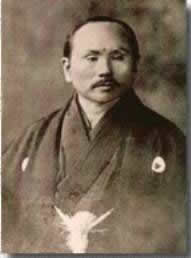 Master Gichin Funakoshi was born in Shuri, Okinawa in 1868. As a boy, he was trained by two famous masters of that time. Each trained him in a different Okinawan martial art. From master Yasutsune Azato he learned Shuri-te. From master Yasutsune Itosu, he learned Naha-te. It would be the melding of these two styles that would one day become Shotokan karate.
Master Gichin Funakoshi was born in Shuri, Okinawa in 1868. As a boy, he was trained by two famous masters of that time. Each trained him in a different Okinawan martial art. From master Yasutsune Azato he learned Shuri-te. From master Yasutsune Itosu, he learned Naha-te. It would be the melding of these two styles that would one day become Shotokan karate.
Funakoshi Sensei is the man who introduced karate to Japan. In 1917 he was asked to perform his martial art at a physical education exhibition sponsored by the Ministry of Education. He was asked back again in 1922 for another exhibition. He was asked back a third time, but this was a special performance. He demonstrated his art for the emperor and the royal family! After this, Funakoshi Sensei decided to remain in Japan and teach and promote his art.
Master Funakoshi passed away in 1957 at the age of 88. Aside from creating Shotokan karate and introducing it to Japan and the world, he also wrote the very first book on the subject of karate, "Ryukyu Kempo: Karate-do". He also wrote "Karate-Do Kyohan" - The Master Text, the "handbook" of Shotokan and he wrote his autobiography, "Karate-Do: My Way of Life". These books and his art are a fitting legacy for this unassuming and gentle man.
Quotes from master Funakoshi:
- "When you look at life think in terms of karate. But remember that karate is not only karate -- it is life."
- "To search for the old is to understand the new. The old, the new, this is a matter of time.
In all things man must have a clear mind. The Way: Who will pass it on straight and well?" - "Karate is a technique that permits one to defend himself with his bare hands and fists without weapons."
- "Just as it is the clear mirror that reflects without distortion, or the quiet valley that echoes a sound, so must one who would study Karate-Do purge himself of selfish and evil thoughts, for only with a clear mind and conscience can he understand that which he receives."
- "He who would study Karate-Do must always strive to be inwardly humble and outwardly gentle. However, once he has decided to stand up for the cause of justice, then he must have the courage expressed in the saying, "Even if it must be ten million foes, I go!" Thus, he is like the green bamboo stalk: hollow (kara) inside, straight, and with knots, that is, unselfish, gentle, and moderate."
- "There are many kinds of martial arts, ...at a fundamental level these arts rest on the same basis. It is no exaggeration to say that the original sense of Karate-Do is at one with the basis of all martial arts. Form is emptiness, emptiness is form itself. The kara of Karate-Do means this."
- "The correct understanding of Karate and its proper use is Karate-do. One who truly trains in this do [way] and actually understands Karate-do is never easily drawn into a fight."
- "Students of any art, including Karate-do must never forget the cultivation of the mind and the body."
- "To win one hundred victories in one hundred battles is not the highest skill. To subdue the enemy with out fighting is the highest skill."
- "The ultimate aim of the art of karate lies not in victory or defeat, but in the perfection of the characters of its participants."
Master Yasutsune Azato ( 1828-1906 )
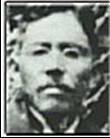 In the Okinawan town of Azato, Yasutsune was born to aTonichi, one of the two highest classes in the Okinawan society. This advantage made it capable to become very well versed. He trained in martial arts under master Matsumura. Besides martial arts, he was an expert on archery, horsemanship and kendo. He gained the station of advisor to the king in both military and state affairs. All information indicats that he had only one student,Gichin Funakoshi. Even his older sons' teaching was left in the capable hands of master Itosu.
In the Okinawan town of Azato, Yasutsune was born to aTonichi, one of the two highest classes in the Okinawan society. This advantage made it capable to become very well versed. He trained in martial arts under master Matsumura. Besides martial arts, he was an expert on archery, horsemanship and kendo. He gained the station of advisor to the king in both military and state affairs. All information indicats that he had only one student,Gichin Funakoshi. Even his older sons' teaching was left in the capable hands of master Itosu.
Master Azato's method of teaching was very strict. He would have Funakoshi repeating the same kata over and over form three to ten months. He would say "The secret of victory is to know yourself and your opponent through careful preparation and observation." This way you will never be caught off guard. Azato kept a very complete registry of all martial artists on the island, listing in detail their abilities and defects..
One incredable story was, master Azato was challanged by Yorin Kanna, the most famous swordmen of Okinawa. Kanna was known not only for his skill but his huge size and strength. Kanna was surprised when he first attacked Azato, for even though master Azato was an expert in Jigen-kenjutsu, he met his adversary unarmed. master Azato was able to unarm Kanna of his sword and bring him to his knees bare handed.
Master Yasutsune Itosu ( 1830-1915 )
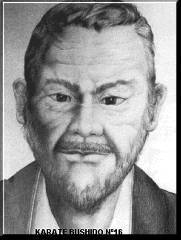 Like his master, Matsumura, master Itosu was born in the city of Shuri, Okinawa. At sixteen, master Itosu began training with master Matsumura. He was a very close friend of master Matsumura's uchi deshi (live-in student), master Yasutsune Azato.
Like his master, Matsumura, master Itosu was born in the city of Shuri, Okinawa. At sixteen, master Itosu began training with master Matsumura. He was a very close friend of master Matsumura's uchi deshi (live-in student), master Yasutsune Azato.
Secretary to the king of Okinawa, Itosu is was instrumental in introducing Karate into the public school systems. To help the teaching, he is credited with developing the Pinan katas.
Master Itosu believed the body should be trained to withstand the hardest of blows, he was renowned for incredible strength in his legs, arms and head. It was said he could crush green bamboo with his vice-like grip. There are many stories that flow from this. One being he would practice punching against the stone walls and would proceed to knock away the stones themselves.
Describing the art in his own words, he said: "Karate means not only to develop one's physical strength but to learn how to defend oneself. Be helpful to all people and never fight against one person. Never try to strike if possible; even when taken unawares, as perhaps meeting a robber or a deranged person. Never face others with fists and feet. As you practice karate, try to open your eyes brightly and keep your shoulders down, stiffen your body as if you are on the battleground. Imagine that you are facing the enemy when you practice the punching or blocking techniques. Soon you will find your own striking performance. Always concentrate attention around you. A man of character will avoid any quarrels and loves peace. Thus the more a karateka practices the more modest he should be with others. This is the true karateka."
Master Sokon “Bushi” Matsumura ( 1797-1889 )
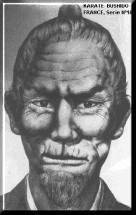 On the island of Okinawa, master Matsumura was born in the city of Shuri. From very early in his life master Sakugawa and master Kushanku trained him. There is information as well to conclude that he was taught by a Chinese master named Iwah, and possibly a master of the Jigen sword school of the Satsuma clan, most likely the master Yashuhiro Ijuin.
On the island of Okinawa, master Matsumura was born in the city of Shuri. From very early in his life master Sakugawa and master Kushanku trained him. There is information as well to conclude that he was taught by a Chinese master named Iwah, and possibly a master of the Jigen sword school of the Satsuma clan, most likely the master Yashuhiro Ijuin.
The military Chief of Okinawa, he worked as a bodyguard and advisor for three different kings: Sho-Ko, Sho Iku and Sho Tai. There are a great many stories following this man. How he attained the name "Bushi", which means warrior, is just one of them. One story goes that the King Sho Ko was gifted a bull from the king of Japan and to test master Matsumura, he posed a challenge between him and the bull. Through intelligent strategy, master Matsumura won and the Okinawan King bestowed the name to him. Through his teaching there were a great many a masters born. Two of which were master Yasutsune Azato and master Yasutsune Itosu.
Master Matsumura is the founding father of Shorin-Ryu karate